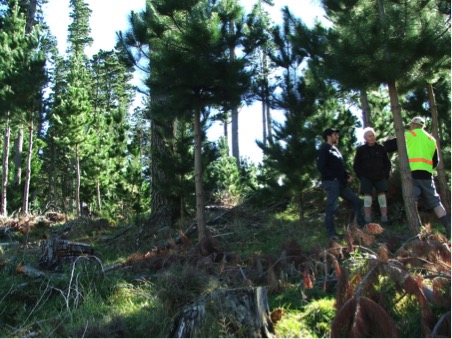Report: Trees for steep slopes

Dean Satchell
Sustainable Forest Solutions
dsatch@gmail.com
Reviewed by Mike Marden, July 2018.
PDF download of this report ».
Please note that the web report is regularly updated whereas the pdf download above is dated July 2018.
Pine, radiata
| Species rating * | |
|---|---|
| Early growth rate | 10 |
| Permanent canopy | 3 |
| Root decay rate | 2 |
| Productivity | 10 |
| Timber value | 3 |
| Coppicing | 0 |
| Total rating | 5.75 |
In a nutshell
Radiata pine could be managed differently on steep erodible slopes. Higher initial stockings than traditionally practiced offer rapid canopy closure and protection from erosion. Innovative practices such as ringbarking could be introduced to cost-effectively reduce tree stockings progressively to numbers suitable for a longer rotation regime, while also improving wood quality and value by controlling knot size and increasing wood density.
The focus of this report is on alternative species to radiata pine that offer productivity while at the same time provide superior erosion prevention to radiata. However, radiata pine could potentially be managed to provide improved erosion prevention in red zoned steeplands.

Standard-practice radiata regimes such as planting 800 stems per hectare and clearfelling in 25 years are not likely to continue on red zoned erodible land because of the risk for significant erosion to occur. The risk for steep slopes to erode significantly increases every 25 years when the trees are harvested, for a period of time called the "window of vulnerability".
Radiata pine, being by far the most widely planted plantation forest species in New Zealand, is the obvious benchmark for comparing other species with. The ratings for each species provided in this report offer a means for comparison.
The issues with radiata pine that make alternatives superior in terms of erosion prevention include:
- Radiata pine's roots rapidly decay so root soil-holding capacity is rapidly lost after harvesting;
- Radiata pine is a commodity timber species and returns dictate that clearfell harvesting is necessary to be economically viable;
- Optimum rotation length is 25 years, therefore the window of vulnerability opens for a period every 25 years.
Nevertheless, there are options available to growers to reduce the risk for erosion in steepland radiata plantations. These include:
- replanting harvested areas immediately with a high stocking of trees, for example 2000 stems per hectare;
- growing radiata pine on longer rotations.
- growing radiata pine under a continuous cover regime whereby coupes or single trees are harvested to maintain a canopy.
It should be noted that although roots rapidly decay after clearfell harvesting, a study of root systems in 18 year old radiata pine in New Zealand showed that root grafting occurs and root systems of thinned trees remain alive after harvesting (Will, 1968). Root grafting begins when radiata pine is about ten years old and increases rapidly from that age to at least 25 years of age (Wood & Bachelard, 1970). Therefore partial harvesting may offer high levels of erosion mitigation.
Disclaimer: The opinions and information provided in this report have been provided in good faith and on the basis that every endeavour has been made to be accurate and not misleading and to exercise reasonable care, skill and judgement in providing such opinions and information. The Author and NZFFA will not be responsible if information is inaccurate or not up to date, nor will we be responsible if you use or rely on the information in any way.

 Farm Forestry New Zealand
Farm Forestry New Zealand